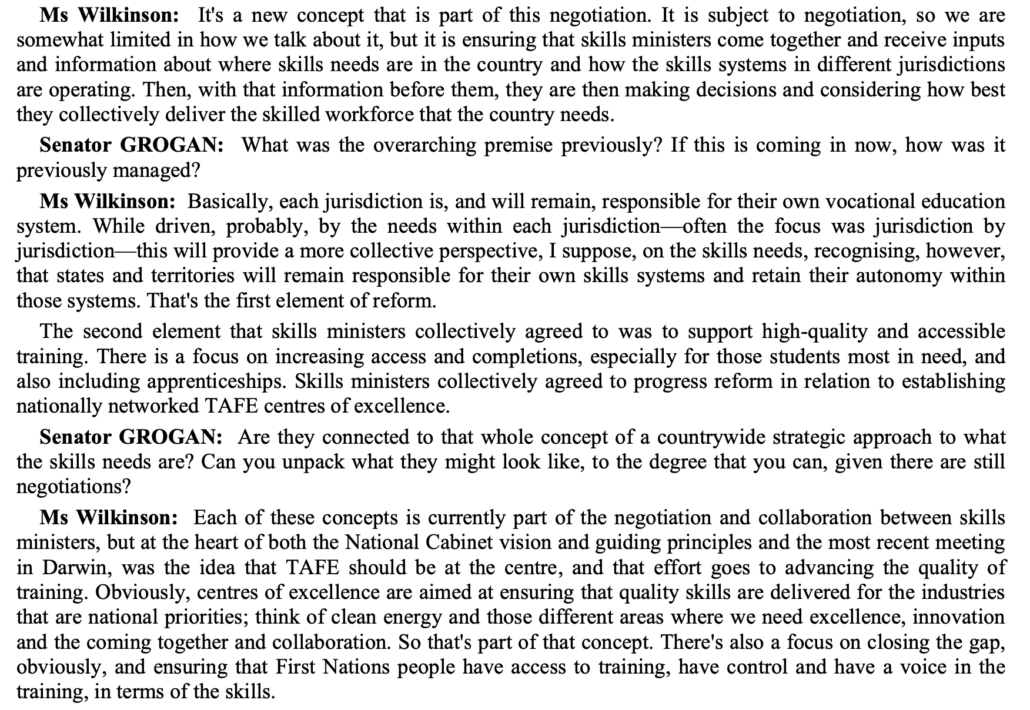Fee Free TAFE funding
In the recent Senate Estimates hearings, officials from the Department of Employment and Workplace Relations provided the following data on the 180,000 Fee Free TAFE and other VET funded places committed to by the Australian government and States and Territories.
Fee Free TAFE and other VET enrolments (2023)

The data shows that there has been a strong uptake in New South Wales, Queensland, Western Australia and South Australia – likely for slightly different reasons, including:
- both New South Wales and Western Australia have the highest student fees for government subsidised courses, suggesting that there was some pent-up demand from non-concession card holders looking to undertake VET studies who could not afford the student fees they would have been required to pay for their course without the Fee Free place (note that concession card holders in all jurisdictions have always been able to access fee free training)
- the demand in South Australia was likely due to the former state government’s prohibitions on TAFE SA being able to offer places in popular courses in Adelaide except as a traineeship. The new government has unwound that decision, which combined with the Fee Free funding from the Australian government has seen students enrol in strong numbers, and
- in Queensland the strong enrolments might be because of the relatively high proportion of funding over many years which has gone to private providers rather than TAFE Queensland. New Fee Free places in TAFE Queensland have clearly been attractive to some students.
In other jurisdictions there has been lower levels of demand.
Victoria was the first jurisdiction to introduce Free TAFE funding some years ago. It may be that demand has dampened because of the proliferation of Fee Free places and this in turn may raise questions about what to expect in future in other jurisdictions.
In Tasmania the government has been making systemic changes to TasTAFE, setting it up as a more autonomous government agency. In other jurisdictions which have undertaken major organisational restructures of their TAFE Institutes (eg Queensland, New South Wales and South Australia) it has been difficult to keep enrolments high while these changes are made and then bedded down.
In the two territories the reasons for their lower enrolments are likely the inverse of one another. That is:
- with the Northern Territory having a relatively more disadvantaged population and a very high proportion of First Nations people (with both cohorts entitled to free VET places irrespective of any fee free funding programs) it is likely that there is less need for additional fee free places, whereas
- in the ACT with its very highly educated population and the very tight labour market nationally and in the ACT in particular there is lower demand for VET training even if the places are Fee Free.
Nationally 83.3% of the Fee Free TAFE enrolments are in TAFE, plus a further 8.7% in the VET divisions of the dual sector universities. Frequently the latter are included in TAFE statistics in NCVER reports – so it is accurate and appropriate to say that 92% of the places have gone to the TAFE sector, with the remaining 7.2% of places going to private providers and just 0.8% to the ACE sector.
Almost all enrolments (95.2%) are in full qualifications, with just 4.8% in short courses.
In terms of the student profile:
- 23.3% are jobseekers
- 2.9% are First Nations students
- 8.3% report a disability, and
- 60% are women
The very high level of enrolments by women is explained by the courses the students are enrolling in:
- 42,565 in ‘care’ courses plus an additional 8,572 in early childhood education and care (ie a total of 51,137)
- 14,737 in digital/tech courses
- 10,773 in construction
- 6,093 in hospitality and tourism
- 2,451 in manufacturing, and
- 52,565 in ‘state priority’ courses eg defence is a key priority in South Australia but less so or not at all in other jurisdictions
- 52,565 in ‘state priority’ courses eg defence is a key priority in South Australia but less so or not at all in other jurisdictions
Data is being collected on completions – to date (bearing in mind the program is only 5 months old) there have been 11,086 completions.
All of these figures are national – officials indicated they were happy to share state-level breakdowns and would provide these subsequently.
‘Shared Stewardship Model’
If The Australian government can get States and Territories to agree, the National Skills Agreement will for the first time be based around a “shared stewardship” model – which might sound a bit obscure but is important. It is also likely to be the reason why jurisdictions have not yet reached agreement on the parameters of the new multi-year funding deal which the National Skills Agreement represents/
The former government had been trying to get States and Territories to agree to more national consistency in the funding subsidies paid to VET providers for key priority qualifications. Former New Zealand Finance Minister, Steven Joyce, in his 2019 review of the VET sector found for example that in 2018 VET providers delivering the Diploma of Nursing in Western Australia were paid $19,963 while those in Queensland were paid just $8,218 – for delivering exactly the same course.
The Australian government is also interested in more national consistency but is looking to work with States and Territories to achieve it (a ‘shared stewardship’ model), rather than imposing it on jurisdictions. It appears that the Australian government is also looking for more transparency on how funding is used.
This interest in greater national consistency is important for government-funded providers because, if/when agreement is reached on more consistent funding rates, the level of subsidies providers receive for the courses they offer are likely to change. Returning to the nursing example – it is likely that Western Australian providers would receive less funding and Queensland providers would receive more.
Here’s what was said on this issue in the Senate Estimates hearing:






